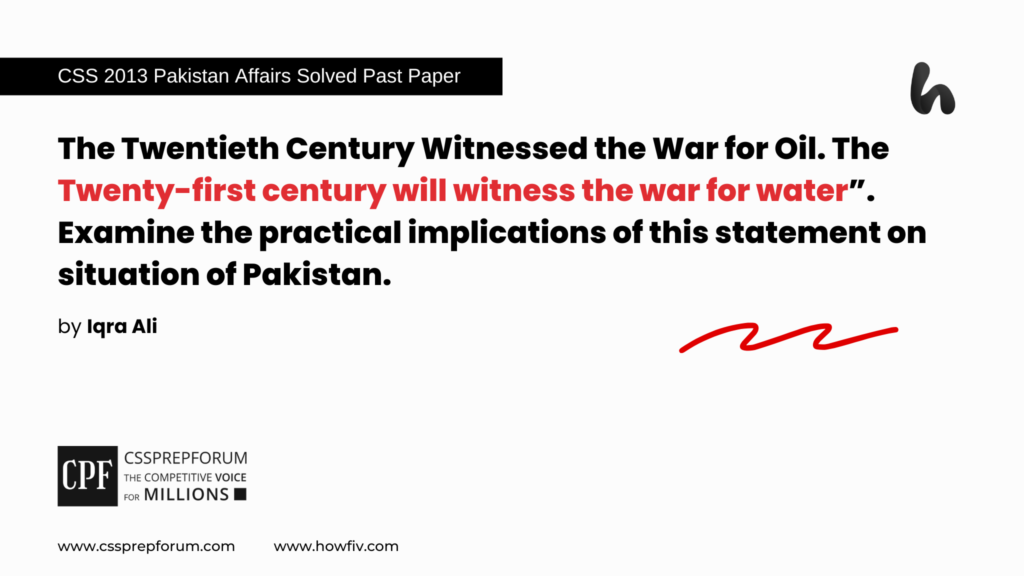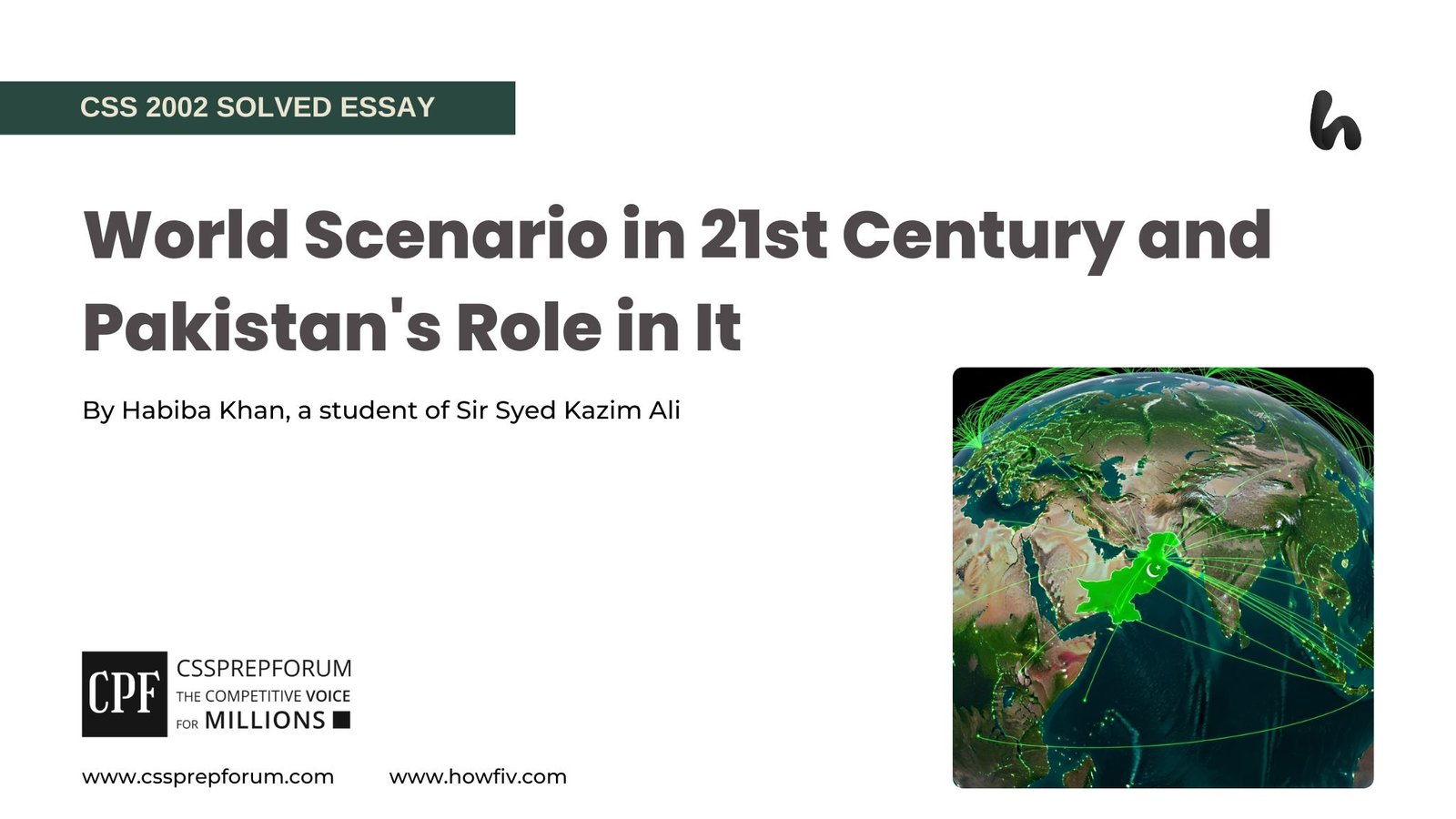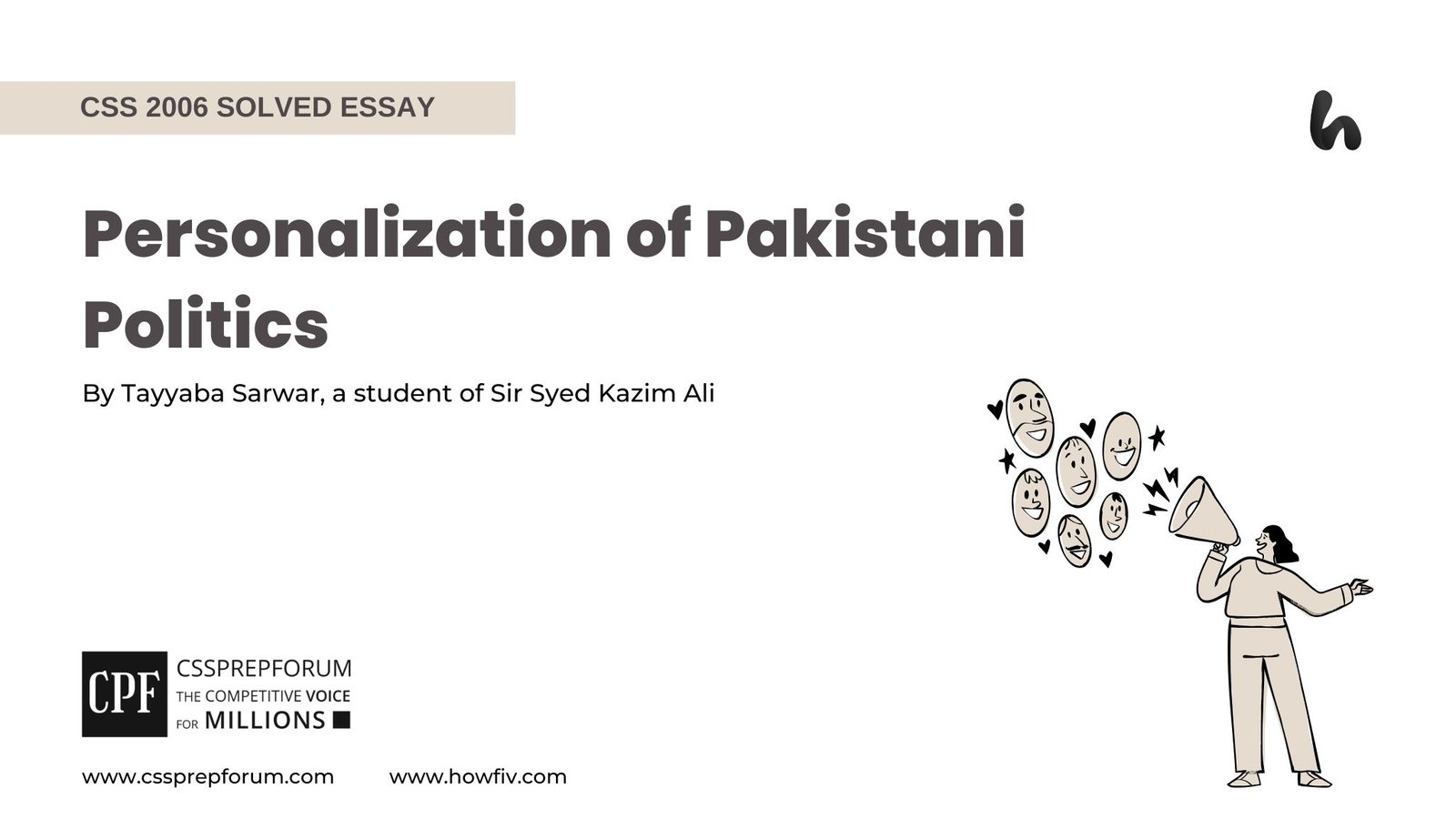CSS 2013 Solved Pakistan Affairs Past Papers | Twenty-first century will witness the war for water
The following question of CSS Pakistan Affairs 2013 is solved by Miss Iqra Ali, the best Pakistan Affairs Coach, on the guided pattern of Sir Syed Kazim Ali, which he taught to his students, scoring the highest marks in compulsory subjects for years. This solved past paper question is uploaded to help aspirants understand how to crack a topic or question, how to write relevantly, what coherence is, and how to include and connect ideas, opinions, and suggestions to score the maximum.

Question Breakdown
In this question, the examiner has asked you to examine the practical implications of the given statement on the situation of Pakistan. Here, the statement implies for the water crisis or scarcity in the country that may be led to war for water. So, you have to examine the implications of water scarcity on Pakistan. Start your answer with an introduction to the issue by including all the leading points of the answer. Then, examine the implications of the crisis in the main body of the answer and support your examinations with valid evidences. Notably, you have to answer in the context provided in the given statement. At the end, conclude your answer.
Outline
1-Introduction
2-Contextualizing the Statement, War for Water in the Twenty-first Century
- ✓ Current Situation of the Water Crisis in Pakistan
3-Examining the Implications of Water Scarcity/Water Crisis in Pakistan that May Ignite the Possibility of War for Water
3.1- At Provincial Level
- ✓ By Increasing Tensions between Punjab and Sindh due to Food and Economic Insecurity
- ✓ By Deepening Divide between Khyber Pakhtun Khawa, Sindh, Baluchistan, and Punjab due to Dispute over Resource Share
3.2- At Regional Level- India-Pakistan Hydro Politics
- ✓ By Prompting Regional Conflict with Arch-Rival India
- ✓ By Increasing Tensions with Afghanistan
4- Way Forwards to deal with the Water Insecurity
- ✓ Diplomatic Engagement for Water Management
- ✓ Climate Adaptation alongside Policy Reforms
5- Conclusion

Introduction
The statement that the twentieth century witnessed a war for oil. The twenty-first century will witness a war for water is an alarm that signals incoming war for survival. It reflects a looming climate change-led water crisis that can pose a challenge to the existence of humanity. In the case of Pakistan, the water crisis portrays geographic pitfalls and its non-sustainable practices while using its water resources. The country’s economic dependence on agriculture sparks the need for water to ensure food security in the wake of population explosion. Thus, it can be assumed that the need for water may ignite the possibility of war for water not only within the state but also at the regional level. For example, India is the upper riparian country to the Indus River, whereas Indus water is the backbone of an agriculture-based economy, and Afghanistan’s Kabul River mixes up with the Indus River. Thus, it is indispensable to promote diplomatic engagements with both countries not only to strengthen cooperation but also for water management and climate adaptation. To conclude, it is the responsibility of the world powers, being leading emitters, to raise funds for the impacted countries and also essentialize moving toward green practices.
Contextualizing the Statement, War for Water in the Twenty-first Century
Generally, necessity ignites a human being’s quest to attain a particular thing. For example, the war for oil in the 20th century was prompted by two factors: first, the necessity of energy sources to operate engines, run industries, and meet the energy needs of human beings. Second, the quest to dominate the world through human development and progress for which fulfilling energy requirements was the paramount concern of world powers around the globe. Similarly, the war for water is a necessity that may ignite the quest to attain the invaluable asset required for the survival of human beings. It is obvious in the case of water because no being on this planet can live without water. In the case of Pakistan, the war for water symbolizes the implication of depleting water resources that are contributing to the water crisis in the country. As a result, the federating units and the state are in the quest not only to fulfill its increasing population’s necessities but also to maintain the economy. The country’s economy is agrarian and thus heavily depends on the availability of water. For illustration, Anatol Lieven aptly describes in the book Governing the Ungovernable that if the Indian economy used to be described as ‘ a gamble on the monsoon, ‘ then the entire Pakistani state can be described as ‘a gamble on the Indus. The reasons for the water scarcity include chronic overuse, climate change, mismanagement of groundwater, outdated canal infrastructure that led to water loss, and lack of reuse systems. Majorly depending on the Indus River system; however, issues emerge with its neighbor India being a lower riparian country and 78% of its water inflow from therein.
- ✓ Current Situation of the Water Crisis in Pakistan
In the present situation, the country is ranked third among the water-scarce countries, as presented in the report led by the International Monetary Fund (IMF). Thus, it is at high water risk, and according to the report of Statista, a German-based platform that serves as a statistic, the stress is assumed to be at the highest level by 2024. Analyzing the following factors can help in understanding how water scarcity may contribute to clashes. First, the population of the country is growing at a rapid pace, approximately at the rate of 2.8%, which means increasing the necessity of water in the coming years. Then, the state renewable water resources account for 0.5%, out of which 95.8% comes from the Indus River water system. From outside the country, 78% of the water originates from India. In 2022, access to safe water only accounted for 50.60% of the total population.
Examining the Implications of Water Scarcity/Water Crisis in Pakistan that May Ignite the Possibility of War for Water
The following points elucidate how water scarcity/ crisis can led to war or war like situation at the provincial and regional level.
At Provincial Level
To manage the distribution of water between the federating units, the government of Pakistan enforced the accord titled Water Apportionment Accord (WAA) in 1991. It established the Indus River System Authority (IRSA) for implementation of the accord to protect the canal water uses and apportions the balance of river supplies among the provinces. However, it has some limitations, such as the lower Indus Basin irrigation system becoming more vulnerable in the post-accord years. According to the Water Apportionment Accord (WAA), Punjab has been allocated with a share of 47.7 %, Sindh-41.5%, Baluchistan-3.3%, and Khyber Pakhtunkhuwa-7.5%. The distribution of water has remained a politically sensitive matter for Sindh, whereas the formation of new canals has turned the controversy in the province extremely volatile and has given impetus to separatist.
- ✓ By Increasing Tensions between Punjab and Sindh due to Food and Economic Insecurity
As I discussed, the water distribution issues have given impetus to nationalist (communalist/parochial) sentiments in the provinces. Similarly, it can increase tensions between Punjab and Sindh, where the latter already accuses the former of dominating at the socio-economic level, which contributes to the marginalization of the rights of other provinces. Thus, it is a matter of great concern that may ignite war for water between the two as both share a history of leveling allegations against each other. Sindh accuses Punjab of depriving its water share, leading to violation of the Accord. However, the Punjab government denounces the claims. Historically, the construction of the Kalabagh dam has remained a source of dispute between the provinces based on the notion that the construction of the dam would majorly benefit Punjab being, the upper riparian region. Apart from the construction of dams, canals also remained a source of dispute between the two units. For example, the Greater Thal Canal and Chashma-Jhelum link canal caused significant diversions that cut down Sindh’s water share. In low-flow periods, Punjab extracts up to 6000 cusecs of water, which impacts agricultural production in Sindh. In the Kharif season, a 35% water shortage paralyzes agricultural production to a noticeable extent. According to the Sindh Abadgar Board, if the situation persists, it would reduce 40% of the agricultural production leading to poverty. Analyzing the situation, whatever the reason, it is evident that water scarcity may ignite parochial sentiments in the Sindhis.
- ✓ By Deepening Divide between Khyber Pakhtun Khawa, Sindh, Baluchistan, and Punjab due to Dispute over Resource Share
Next, KPK claims that it did not get fair water share as defined in the Accord based on the stance that water share is less than irrigation needs. In addition, the share fails to support any hydroelectric project in the province. As a result, the federating unit, being an upper riparian, encounters water shortage, and it increases its dependence on the federal government that controls dams and reservoirs. In the wake of the water shortage, it is evident that the issue will be intensified, which may ignite parochial sentiments in the Pakhtun community. Likewise, Sindh and KPK accuse Punjab of diverting more water than the agreed share as per the Accord. Then, the above-mentioned canals are a source of dispute between Punjab and KPK as it reduces the water supply to the latter. Apart from this, KPK and Baluchistan opposed the construction of the Kala Bagh dam, which was a significant step to encounter water scarcity in the country. Concerning Baluchistan, as it depends on Guddu and Sukkur barrages, Sindh already encounters water shortages because of more diversion than provided in the Accord. It is also caused by a lack of infrastructure in the province. So, due to less reliable surface water, the province relies on tube wells and underground water, and over-extraction is contributing to the water crisis. These water shortages, indubitably, may cause inter-provincial strife by increasing food insecurity.
At Regional Level- India-Pakistan Hydro Politics
The management of Indo-Pak Transboundary Rivers is governed by the Indus Waters Treaty of 1960, dividing six rivers of the Indus basin between the two, which gives the latter control over the Indus, Jhelum, and Chenab rivers and the former over Ravi, Beas, and Sutlej Rivers brokered by World band in 1960. However, India’s hydroelectric projects over Pakistan’s rivers, such as the Kishanganga and Ratle hydroelectric power projects, remained a cause of discord between the two. Thus, in the wake of the climate-led water crisis, there is a possibility of confrontation between the two states over water use. The following points describe how water crisis/ scarcity may cause war or confrontation at the regional level.
- ✓ By Prompting Regional Conflict with Arch-Rival India
As I discussed, water scarcity may ignite tensions between the two countries over the use of water, as provided in the Indus Water Treaty of 1960. The confrontation in the present is motivated by agricultural and energy needs; however, in the wake of climate-led water shortages, it will be more about the war for survival. The agricultural dependence on Indus River water accounted for 90%. Thus, it is obvious that in the wake of water scarcity, food insecurity, and economic collapse will cause internal instability. As a result, it can lead to an open confrontation between the two states. Then, melting glaciers in the Himalayas and climate change-led erratic monsoons threaten water flows. So, the countries might take aggressive actions to secure water resources. Historically, the hydroelectric projects, such as the Kishanganga project on the Neelam River (Jhelum), Salal project on the Chenab River (resolved), Wullar-Tulbul Barrage on Jhelum River, and Baghlihar project on the Chenab River remained a source of dispute between the two states. The Indian hydropower projects are referred to as Indian water aggression motivated by historical concerns that India, being an upper riparian, may block water access as a political strategy against Pakistan.
- ✓ By Increasing Tensions with Afghanistan
Then, in the case of Afghanistan, confrontations over water access can morph into war for water in the wake of intense water scarcity. The Kabul River merges with the Indus River and is one of the major water sources supporting the agricultural production of both countries. However, dam projects on the river can reduce water flow to KPK, which can increase food insecurity in the area. The Shahtoot Dam Project of Afghanistan, meant to supply drinking water to Kabul, also reduces water flow to Pakistan, and unlike IWT, there is no formal water-sharing agreement between the two states that prohibits any discord. Thus, in the wake of climate-led water scarcity/crisis, the water-sharing issues may ignite tensions over the use of water between the two states.
Way Forward to Deal with Water Insercurity
To prevent inter-provincial or regional conflict over water resources, it is indispensable to devise a pragmatic plan that not only introduces new strategies but also implements them. It is worth noting that poor water management, climate change, and population explosion are among the major driving factors of the crisis. Here, addressing climate change and population explosion requires broad-range strategies. However, water management may be the viable option to start with. The following points illustrate real-time options to counter any escalation over water resources.
- ✓ Diplomatic Engagement for Water Management
As I discussed, water management can be the right option to start with without wasting time only devising strategies. Meanwhile, it also helps in addressing climate change and population explosion. Both countries, India and Pakistan, must promote diplomatic engagement not only to strengthen IWT but also to take action for better water management. Notably, it is high time to realize that the menace of climate change is posing a greater threat to humanity that must be tackled instead of strengthening hegemonic designs. There will be no hydro-politics, hegemony, or command of one nation over another if there is no water. In this respect, both countries can devise plans of action to promote sustainable use of water. In the case of Pakistan, opportunities may include the implementation of Integrated Water Resource Management (IWRM) that helps consider multiple aspects, including environmental sustainability, water demand, and supply. Other options may include infrastructure development, the introduction of better irrigation techniques, water conservation, and rainwater harvesting. Similarly, diplomatic engagements and negotiations with Afghanistan for water management can help abate the crisis.
- ✓ Climate Adaptation alongside Policy Reforms
Next, the broad-range strategy to counter climate change may include climate adaptation as the first option to consider. However, it is indispensable to note that Pakistan’s economy is not in a state of lifting the burden. The country needs funds to combat the adverse impacts of climate change. It is obvious that climate adaptation requires funds to develop infrastructure, climate-resilient agriculture, and early warning systems and to preserve health and the ecosystem. Noteworthy, the requirement must be fulfilled by the world powers, not in the name of debt, help, or favor, as the country contributes only 1% to global greenhouse gas emissions (GHG). Thus, it is the responsibility of the largest emitters to not only stop the anti-environment practices but also support the countries marred by the impacts of climate change due to their actions. In the case of Pakistan, there is a huge gap between policymaking and its implementation that needs reforms to tackle. For example, constructing dams is one of the options to promote water management, but inter-provincial discords abstain from its provision. Thus, the country needs a unique solution to overcome the obstacles in the way of implementation.
Conclusion
To conclude, the war for water elucidates the implications of water scarcity in Pakistan. The war for water symbolizes war for survival in the present. So, the areas where water resources are available may indulge in conflicts, confrontations, disputes, or full-fledged wars to get control over water resources. As the country’s agro-based economy heavily depends on the Indus River, it is obvious that its relations with India and Afghanistan may encounter challenges due to the issue of water sharing. In addition, inter-provincial water disputes may give impetus to parochial nationalism. Thus, it was a two-pronged war for the survival of the country. It’s high time to devise a National Plan of Action to empower water governance because water management can be the best option to start saving water. However, the government must prioritize a long-term range strategy at the global level to abate climate change-led water crisis.
CSS 2013 Solved Pakistan Affairs
CSS Solved Past Papers’ Essays
Looking for the last ten years of CSS and PMS Solved Essays and want to know how Sir Kazim’s students write and score the highest marks in the essays’ papers? Then, click on the CSS Solved Essays to start reading them.
CSS Solved Essays
CSS Solved General Science & Ability Past Papers
Want to read the last ten years’ General Science & Ability Solved Past Papers to learn how to attempt them and to score high? Let’s click on the link below to read them all freely. All past papers have been solved by Pakistan’s top CSS GSA coach having the highest score of their students.
General Science & Ability Solved Past Papers












